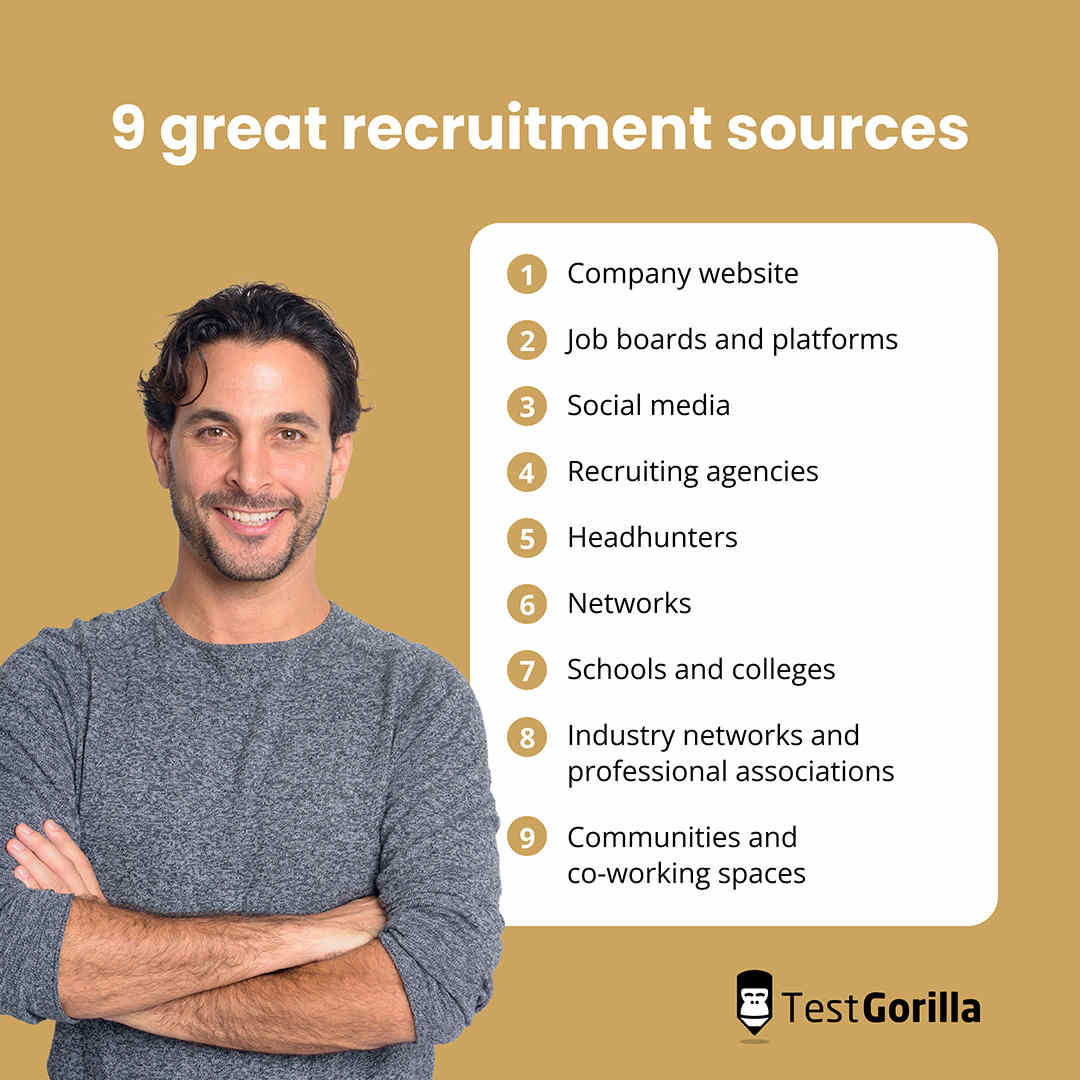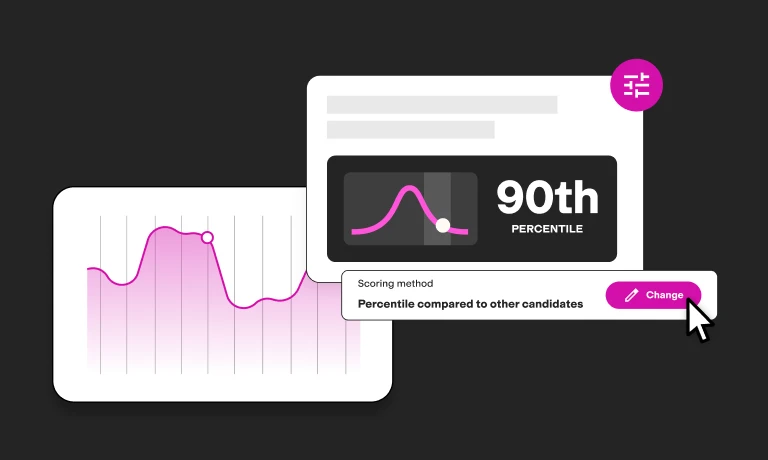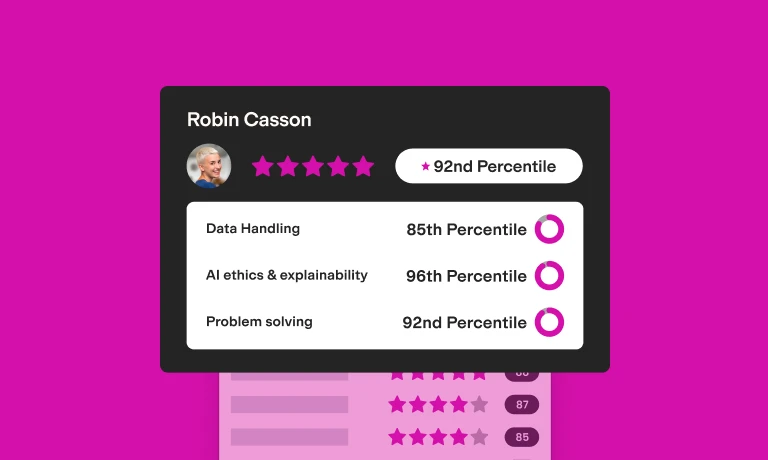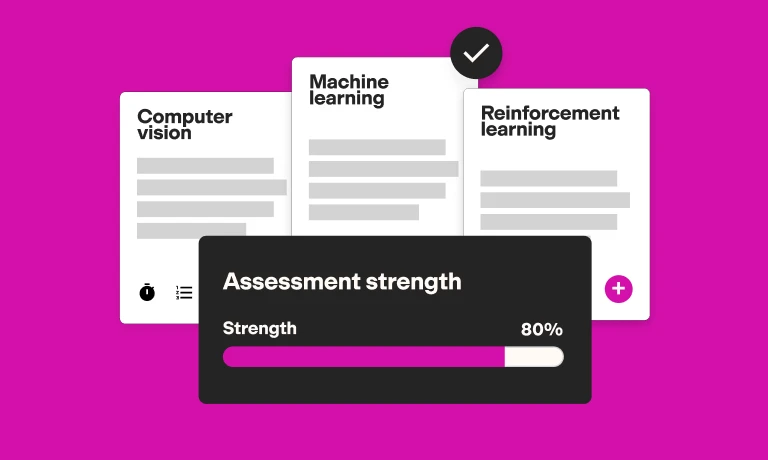In the last few years, many workers have resigned, taken personal breaks, or moved to flexible working. This has left the job market with talent shortages and growing skills gaps, making hiring more challenging than ever.
Of course, employers can provide better pay, flexibility, and more robust benefits to get candidates to accept a job offer. However, finding quality applicants in the first place can often feel like an uphill battle. Today’s recruiters have exhausted many of their hiring sources and are now competing for the same top talent.
That’s why we’re here to lend a hand. We’ve compiled a list of 9 recruitment sources – plus platforms and tools to use – to help you find and hire the best talent in the job market before the competition does. Let’s dive in.
9 great recruitment sources (plus tools, pros, cons, and tips)
Online platforms
1. Company website
Your company’s website will likely have a careers page. Here, you can share open roles, job descriptions, and links for applicants to apply for available positions.
Pros
Sources applicants who are already interested in your company
Gives you complete control over the content and presentation of open positions
Enhances your employer branding by showcasing the company’s culture and values
Cons
Has limited reach – i.e., it only works for individuals who visit your website
Success depends on how much traffic your company website receives
Lack advanced features like candidate communication systems, pre-employment screening tests, and reporting and analytics
Top tips for maximizing success
Direct candidates from your company website to a pre-employment testing platform like TestGorilla so you can easily access its additional features
Link your career page to external recruiting websites and social media platforms to expand your reach
Demonstrate your mission, values, and culture across your company website – not just the careers page – to improve employer branding
2. Job boards and platforms
Online job boards and recruiting platforms are a great way to reach a broader pool of job seekers – including those who don’t know about your company. You can post open roles, share job descriptions, and track applications directly on the job board website or through your applicant tracking system.
LinkedIn, Indeed, Google Jobs, and ZipRecruiter are popular platforms that can show vacancies at various companies across a range of industries. But, since many use these platforms, it can sometimes be difficult to identify quality candidates and gain an edge over other recruiters.
Consider adding the following platforms to your recruiting sources to access top talent and niche candidate profiles:
Glassdoor
Glassdoor shows applicants more than just open roles and job descriptions. They can see existing and prior employees’ reviews, plus the pros and cons of working with your company. Encourage your employees to post reviews of your company to attract candidates aligned with your company’s culture and working practices.
GitHub
Catered to developers, GitHub is an ideal source for tech talent, as you can explore the platform and see what today’s top developers are working on. Individuals use GitHub to share their coding skills, manage version control, and work on open-source projects – making it easier for you to verify candidates’ technical abilities early in the application process.
Kaggle
Kaggle is an online community of data science and machine learning enthusiasts. It runs frequent data science contests and competitions, and you can view these results to spot highly skilled talent.
Stack Overflow
Stack Overflow is an online forum that lets software developers and programmers share ideas, ask questions, and participate in discussions. You can view profiles and filter talent by their area of expertise.
AngelList
While AngelList has a focus on tech, it gathers candidates and hiring companies from various industries. It’s a great place to view profiles and source candidates – especially ones interested in working with growing businesses and start-ups.
FlexJobs and Remote.co
Both FlexJobs and Remote.co cater to companies and workers interested in flexible and remote job opportunities. You can use the platforms to find part-time employees, freelancers, and other contractors.
Idealist
Idealist can help you source candidates for jobs in the non-profit space. You can identify applicants who share your company’s passion and even recruit volunteers and interns.
Pros
Reach a broad audience of active job seekers
Post quickly and conveniently to quicken your hiring process
Most platforms offer metrics and analytics to track the performance of posts
A few platforms like LinkedIn offer “in-mail” to communicate with candidates
Cons
Can be overcrowded with listings, making it difficult to stand out
Companies often receive a large number of job applications that need to be manually screened, taking up valuable time and resources
No way to verify candidates showcase their own skills and projects on websites like GitHub, Kaggle, and Stack Overflow
Top tips for maximizing success
Use role-specific skills assessments to save time and quickly identify candidates who are qualified for the position
Use job boards that offer flexible pricing and free features if you’re working with a lower budget
If it suits your budget, pay for sponsored job posts and ads that’ll help you stand out among competitors
3. Social media
Social media platforms are another excellent source for finding and attracting talent. LinkedIn is an obvious choice, as it focuses primarily on career and work-related social networking. You can search for prospective candidates easily and contact them directly on Linkedin.
In addition to LinkedIn, you can use social media platforms like Facebook, Instagram, and Twitter to source candidates effectively. However, your social media hiring strategy shouldn’t end there.
You can use the social media platforms below to boost your employer brand and, essentially, promote your company to prospective applicants.
TikTok
TikTok is a unique place to attract Millennial and Gen Z candidates. You can share short-form video content to showcase your company’s working culture, employee benefits, open roles, and more. Engage with users who show interest in open roles and interact with your content by replying to their comments.
On Pinterest, you can create “boards” to share pictures and videos of your office, teams, job-related attributes, and more. Add engaging descriptions and titles for each post to boost your reach. This is a creative solution to establishing your employer brand and an effective way to source potential applicants.
Pros
Reaches a broad and diverse audience of active and passive candidates
Offers a creative way to hire by showcasing your company’s culture, values, and working styles through photos, videos, and more
Supports targeted advertising, enabling you to reach candidates with specific skills, qualifications, or interests
Offers flexible pricing (including free plans), so you can access features that work for your budget
Cons
Challenging for your job listing to stand out among the high volume of posts on social media
Time-consuming to screen a higher volume of unqualified candidates
Can be expensive to run targeted ads to source qualified candidates
Top tips for maximizing success
Create a custom assessment for applicants who land on your job post so you can identify those who fit your minimum requirements before moving them to the next stage of hiring
Be consistent with your employer brand across different platforms
Post frequently to build a following of potential candidates
Interact with talent through comments and messages to create a sense of community and connection
The best insights on HR and recruitment, delivered to your inbox.
Biweekly updates. No spam. Unsubscribe any time.
Recruiting experts
4. Recruiting agencies
Recruiting agencies use their own networks and hiring expertise to help you find and hire suitable candidates for your open roles.
They serve as intermediaries between employers and job seekers and help screen and match candidates to open positions. These agencies typically work with many clients and focus on filling junior, middle, or senior-level roles.
Consider using the following platforms and solutions to access the best candidates.
Applicant tracking systems (ATS)
Applicant tracking systems like Greenhouse, Lever, and TeamTailor help you post open roles to job boards, organize applications, and manage and communicate with applicants. You can also invite external recruiting agencies to use your ATS platform.
Many ATSs integrate with top pre-employment screening software, too, so you can screen candidates using online tests rather than manually.
Recruiter
Recruiter is an online, on-demand recruiting platform that helps source candidates on your behalf. Depending on your needs, Recruiter can also screen candidates before sending them your way.
Pros
Provide access to a broad pool of skilled and qualified talent
Conduct initial candidate screening, saving you time and effort
Typically work quickly, filling vacant positions faster than other sources
Only paid if they’re successful in finding and closing a new hire
Cons
Rely only on active job seekers, missing out on potential top talent that hasn’t engaged directly with the agency
Can’t represent your employer brand in the same way you can
Struggle with finding candidates who fit your company’s culture and values – often leading to mis-hiring, which can be costly and disruptive
Top tips for maximizing success
Thoroughly research your recruiting agency to check that they’re experienced in hiring for your industry and role type before you work with them
Carefully explain your employer brand and how you want to be represented in the job market to the recruiting agency you select
After conducting role-specific tests, put candidates through personality and culture assessments to ensure their traits, values, and working styles align with your company
5. Headhunters
Headhunters, also known as executive search firms, are specialist recruiters who can support you with sourcing and hiring senior-level candidates for key positions in your company.
They proactively identify, approach, and persuade potential candidates to consider moving to your company. Importantly, unlike recruiting agencies, they reach out to passive candidates who may not be actively seeking new opportunities but could be a good fit for the role.
Here’s an effective recruiting tool many headhunters use that you can consider using, too:
LinkedIn Recruiter
LinkedIn Recruiter uses LinkedIn’s existing talent base and provides additional features for headhunters and recruiters. For instance, you can sort candidates by skills, qualifications, and experience, as well as by filters like “open to work.” The platform also enables you to manage and communicate with candidates easily.
Pros
Provide access to specialized and highly skilled talent, which helps source candidates for hard-to-fill roles
Usually work with only a handful of clients at a time, giving them more time and resources to focus on their search and pre-screening process
Identify skilled talent and proactively build relationships with even those who aren’t actively looking for jobs
Can conduct confidential searches without disclosing your company’s identity
Cons
Significantly more expensive than most other recruitment sources for top talent
Limited understanding of your company’s culture and values can lead to mis-hiring, which is particularly damaging for senior and leadership-level roles
Less transparency in the recruitment process makes it harder to track progress and candidate interactions
Top tips for maximizing success
In addition to using personality and culture tests, ask headhunters to roll out leadership tests to check if candidates will fit well into senior roles at your company
Also, add situational judgment tests for senior positions so you can see how candidates respond to different scenarios and evaluate if they’ll set the right examples for their teams
Ask headhunters to use your preferred pre-employment software with built-in communications tools so you can track progress and interactions
Networks
6. Employee referral programs
Companies often implement employee referral programs, which encourage current workers to recommend suitable candidates for open positions in the organization.
When the company hires someone an employee referred, that employee typically receives a cash reward or other incentive.
You can use the tool below to create and run your employee referral program.
Applicant tracking systems
Some ATSs like Workable have a feature that lets you create an employee referral program. Your employees can use a workable link to refer suitable candidates for an open role.
And since ATSs typically integrate with pre-employment testing platforms like TestGorilla, you can screen your referred candidates easily.
Pros
Give you access to talented individuals already familiar with your company’s culture and values
Current employees pre-screen candidates, saving you time and effort
Referred employees tend to have a higher retention rate, as they have an existing sense of community in the company through their connections
Relatively inexpensive to implement and provides good value for money
Cons
Risk of favoritism and other biases when employees refer friends, family, or close personal connections
Over-reliance on employee referrals can result in a lack of diverse candidates and fresh perspectives
You may miss better-qualified candidates available in the job market
Top tips for maximizing success
Put candidates through problem-solving and critical thinking skills tests to evaluate their abilities to think outside the box and bring new perspectives
Conduct one-way video interviews to assess candidates’ observable behaviors, and use interview scorecards to promote objective decision-making
Add employee referrals to your hiring program, but don’t use it as your only hiring source
7. Schools and colleges
Many companies run programs to establish partnerships with high schools, colleges, business schools, and other educational institutions.
These help identify and attract potential candidates for future opportunities such as internships, graduate programs, and entry-level jobs.
Consider using the tools below to source top talent from colleges and universities.
Avenica
Avenica is a platform you can use to find entry-level talent. The company’s team builds a large candidate pool, then engages and coaches them to get them career-ready. Then, Avenica matches applicants to hiring companies based on skills, behavioral attributes, and culture fit.
CollegeGrad
With CollegeGrad, you can post your open roles and source entry-level talent from a wide database of students and college graduates.
College job boards
Many universities and colleges have their own job boards where you can post your open positions. This is a great way to source top talent from a specific university – especially if that university is known for particular skill sets.
Pros
Offer access to emerging talent you can identify and encourage from an early stage to build candidate pipelines
Introduce you to diverse talent with different backgrounds and perspectives
Hiring candidates at the start of their careers makes it easy to train and mold their skills to align with your organization’s needs
Students and young talent are more likely to stay with your company long-term if you invest in hiring and developing them from early on
Cons
Difficult to accurately assess candidates’ skills and abilities at the early stages of their careers
Many companies compete for candidates from the same schools and universities, making it challenging to stand out
Costly, time-consuming, and resource-heavy to set up campus recruitment events
Top tips for maximizing success
Rolling out cognitive ability assessments, such as numerical and verbal reasoning tests, is a great way to hire for skills rather than experience
Language and typing tests can also help you evaluate skills required for interns and graduates who work on presentations, communications, meeting minutes, and administrative tasks
Use campus events to strengthen your employer brand and tell students about your company’s culture, values, and employee benefits
8. Industry networks and professional associations
Industry networks and professional associations are organized groups that bring together professionals and companies in a specific industry or area of expertise. These associations provide a platform for recruiters, hiring managers, and other professionals to connect, collaborate, and refer candidates for potential roles.
Here are some examples:
American Accounting Association
The American Accounting Association is a network that caters to accountants in the United States. You can post a job on the association’s online job board to reach highly skilled accounting professionals.
The website also has news on networking events you can attend to connect with potential accountant candidates.
The Institute of Electrical and Electronics Engineers
Operating on a global scale, the Institute of Electrical and Electronics Engineers is a professional association for engineers in the electrical and electronics industries.
You can use the association’s website to browse its various committees and societies, find members in your area, and more to source excellent engineering talent.
Pros
Provide access to highly skilled and experienced candidates
Candidates who come through referrals are already pre-screened to some extent and more likely to succeed in the role
Ability to source candidates with niche expertise who are difficult to find in the external job market
Help you build your talent pipeline and nurture relationships for future hires
Cons
Prone to bias and favoritism, as individuals could promote less qualified candidates solely based on their connections
Lack of diversity and different perspectives, with many candidates coming from the same backgrounds
Membership fees can add to your recruiting costs
Top tips for maximizing success
Create a tailored pre-employment testing program for a well-rounded perspective on candidates to reduce bias in hiring
Use situational judgment tests to look for candidates who bring unique approaches to different scenarios
Research thoroughly to ensure you’re investing your time and resources in an association that gives you access to diverse, high-quality candidates
9. Communities and co-working spaces
Many recruiters now tap into communities of professionals from a specific background – for instance, communities for women in tech or candidates of color.
Co-working spaces also work as communities, offering a space for recruiters to meet and connect with diverse candidates from varying backgrounds and skill sets.
Here’s an example of a platform focusing on a particular community of candidates:
Mogul
Mogul is a global platform designed to engage, develop, and empower women. It offers diverse content for women and networking opportunities to help build their careers. It’s a great community to find the best women in the job market.
Pros
Access to diverse candidates from different backgrounds
Physical co-working spaces let you observe candidates' traits and behaviors before approaching them for roles
Great way to source freelancers and independent contractors
Cost-effective compared to other recruitment sources for top talent
Cons
Requires effort and time to build connections and identify potential candidates
Targeting talent only from particular communities and backgrounds could come across as biased
Individuals may move to other co-working spaces, making it challenging to maintain relationships with them
Top tips for maximizing success
Attend community events and co-working space socials as a quick way to form connections and identify talent
Engage with online communities through their social media pages (a great and inexpensive way to source talent)
Use these sources as part of your broader hiring strategy, not as your only ones
How TestGorilla can enhance hiring across all your recruitment sources
With talent shortages, skills gaps, and low employee engagement levels, it’s become increasingly difficult to source and hire top talent. Thankfully, you can combat these challenges by turning to top recruiting sources.
You can use several recruitment sources – like job boards, social media sites, employee referrals, school and college programs, headhunters, and more. Each has its advantages and drawbacks, so it’s essential to consider them from all angles. You should also use a combination of sources to maximize your chances of recruiting success.
Whichever methods you choose, combining them with pre-employment screening tests is the best and most effective way to find the top candidates and evaluate them objectively.
TestGorilla’s extensive library boasts more than 300 tests – including tests for role-specific skills, personality, culture add, and cognitive ability. You can also use TestGorilla’s one-way video interview software and candidate communication tools to source, screen, engage, and hire the best talent in the market.
Schedule a free 30-minute demo, take the product tour, or sign up for a free plan to explore how TestGorilla can improve your hiring process.
You've scrolled this far
Why not try TestGorilla for free, and see what happens when you put skills first.















